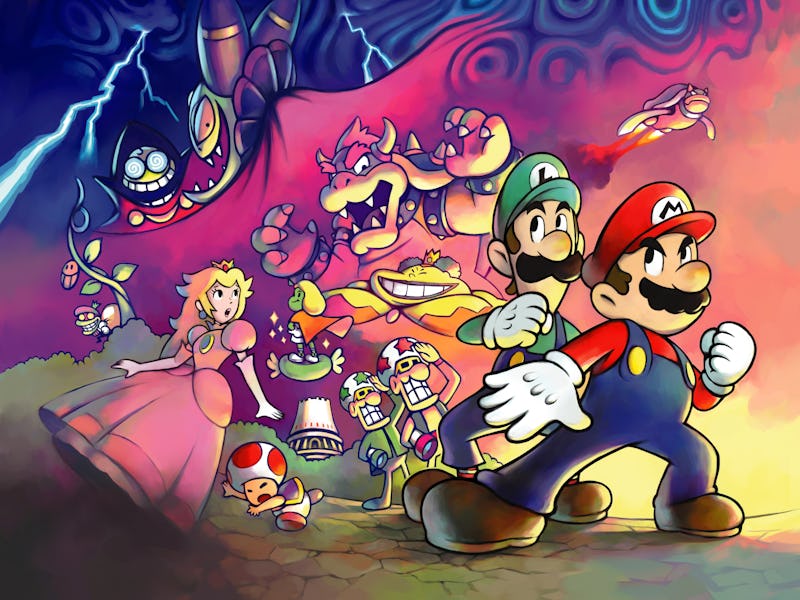Mario & Luigi: Superstar Saga Is the Bros.’ First Great RPG Experiment
Game Boy Advance games have officially hit Nintendo Switch Online.

By design, handheld gaming devices offer smaller, more intimate experiences than console games. That’s not to say smaller is bad: through megahits like Pokémon Red and Blue, Nintendo was reaching levels of market dominance with their Game Boy unheard of in consoles. First released in 1989 and given a refresh with the Game Boy Color in 1998, the Game Boy was so popular that radically upgrading it didn’t make much sense for years.
This delay bought Nintendo something incredibly precious in the world of video games: time. The Game Boy Advance, finally released in 2001, was the first of Nintendo’s Game Boys to move from portrait mode to landscape, giving a wider, almost cinematic screen. It was Nintendo’s first move to bridge the world of handheld games and consoles, a philosophy that eventually found its biggest success in the Switch.
But long before the Switch, the GBA had to prove itself as a console that could provide a unique playing experience. It found the perfect vehicle where Nintendo finds perpetual inspiration, Mario. Or rather, Mario and friends and enemies, in Mario & Luigi: Superstar Saga, available right now if you’ve subscribed to Nintendo Switch Online + Expansion Pack.
Here’s a look at the assortment of Game Boy and Game Boy Advance games on Switch.
Mario games are typically not plot-heavy. In their earliest iterations, the stories were mostly framing mechanisms designed to propel Mario from the beginning of a level to the end. But as the franchise deepened, a light-hearted quality became crystal clear. Let Link and Zelda have their dramatic, world-saving adventures, but Mario and Princess Peach would always emerge with smiles on their faces surrounded by cheering Toads.
Superstar Saga took the comedy implicit in Mario games and brought it to the forefront. The company launched a promotional knock-knock joke contest before the game’s launch, judged by Mario and Luigi and Kathy Griffin. The game’s developer, AlphaDream, took explicit inspiration from the Mario RPGs that had come before it, especially Paper Mario. Shigeru Miyamoto, the game’s producer, offered some guiding words: “give people a sense of a new adventure for Mario and Luigi,” director Yoshihiko Maekawa would later recall in an interview with GameInformer.
The game starts with some diplomatic drama. The Mushroom Kingdom is receiving a special Goodwill Ambassador from the neighboring Beanbean Kingdom, but it’s all a ruse. This so-called Goodwill Ambassador is none other than Cackletta, an evil witch, accompanied by loyal follower Fawful. The two steal Princess Peach’s voice, leaving her only able to utter the foulest of language, shocking her loyal subjects.
This is not your traditional Mario game.
Toad makes his way to the home of Mario and Luigi, where he finds Mario taking a shower. Mario quickly gets dressed and heads to the palace, where he finds his nemesis Bowser equally mad. With Peach only able to speak words so monstrous they can only be depicted via emoji, he doesn’t even want to kidnap her anymore. The two decide to team up to save Peach’s voice.
And there’s Luigi, hanging around. When he and his team were looking back at the original game Maekawa told GameInformer, “we definitely thought that, "yeah, he is getting perhaps teased a bit too much.” Everyone forgets Luigi’s name all the time, and he’s generally seen as not having much worth. This is what life was like before the Year of Luigi.
But Luigi is far from useless in Superstar Saga. He’s crucial, both in battle and walking around. The Mario Bros. meet the Starshade Brothers, two military-minded Toad equivalents who even wear red and green. The brothers Starshade team them special attacks they can accomplish jumping on each other’s back, like spin moves and high jumps. Luigi is important!
In fight modes, gameplay is simple but gets the job done. There are dodges and special attacks available, very much in the mode of Paper Mario. The fighting doesn’t get in the way of the jokes, which is crucial for any game like this. Superstar Saga isn’t a major Mario game, but it shows the sheer endurance of this series. Even the smaller games are must-plays.